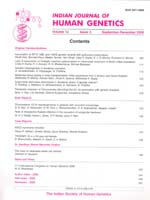
|
Indian Journal of Human Genetics
Medknow Publications on behalf of Indian Society of Human Genetics
ISSN: 0971-6866
EISSN: 0971-6866
Vol. 16, No. 3, 2010, pp. 133-137
|
 Bioline Code: hg10028
Bioline Code: hg10028
Full paper language: English
Document type: Research Article
Document available free of charge
|
|
|
Indian Journal of Human Genetics, Vol. 16, No. 3, 2010, pp. 133-137
| en |
The NQO1 allelic frequency in hindu population of central India varies from that of other Asian populations
Parihar, Sher S. & Chauhan, U. K.
Abstract
Context: The enzymes encoded by the polymorphic genes NAD (P) H: quinone oxidoreductase 1 (NQO1) play an important role in the activation and inactivation of xenobiotics. This enzyme has been associated with xenobiotic related diseases, such as cancer, therapeutic failure and abnormal effects of drugs.
Aim: The aim of the present study was to determine the allelic and genotypic frequencies of NQO Hinf I polymorphisms in a Hindu population of Central India.
Settings and Design: Polymorphisms of NQO1 were determined in 311 unrelated Hindu individuals.
Materials and Methods: Polymerase chain reaction- Restriction Fragment Length Polymorphism (PCR-RFLP) analysis in peripheral blood DNA for NQO1 Hinf I polymorphism was used in 311 unrelated Hindu individuals.
Statistical Analysis: Allele frequencies were calculated by direct counting. Hardy Weinberg Equilibrium was evaluated using a Chi-square goodness of fit test.
Results: The observed allelic frequency was 81% for C (wild) and 19% for T (mutant) in the total sample.
Conclusions: The allelic frequency of "C" was higher than in other Asians (57%), but similar to Caucasians (81%). The genotype distributions for Hinf I polymorphisms were in Hardy-Weinberg equilibrium.
Keywords
Cancer, NQO1, polymorphism
|
| |
© Copyright 2010 Indian Journal of Human Genetics.
Alternative site location: http://www.ijhg.com/
|
|
